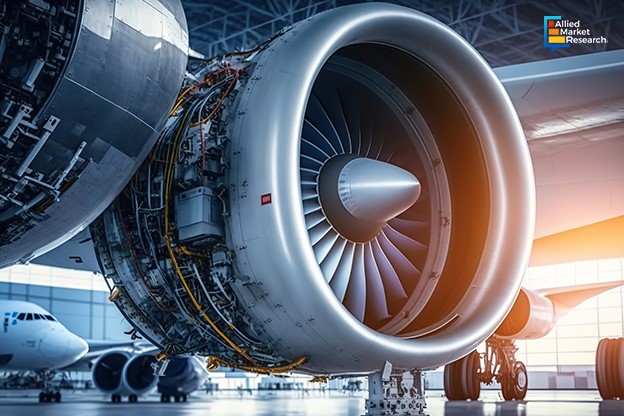Advanced Aircraft Engine Forging Technologies in Which Aviation Businesses Should Invest

7 May
2024
Highlights
- Introduction
- Advanced technologies in aircraft engine forging
- Recent acquisition and collaboration in the sector
Aircraft engine forging is the process of shaping metallic parts for airplane engines by applying compressive force through various forging techniques. The manufacturing process, employing presses, dyes, or hammers, requires meeting the stringent standards of durability, performance, and strength required in aviation applications. In the forging process, the internal grain of metal undergoes deformation to conform to the shape of the metal part, resulting in a uniform structure that improves strength. These forgings are classified as warm, hot, or cold based on the temperature at which the processing occurs.
Closed die forging has gained popularity due to its cost-effectiveness
The forging process is categorized into open-die forging and closed-die forging. Closed die forging produces stronger products due to the uninterrupted grain flow throughout the metallic part, improving its overall strength and performance. Precision machining of forging dies in closed die forging allows the production of shape or near-net shape products with tight tolerances. This reduces extensive post-machining operations, resulting in cost savings.
Closed die forging enables precise control over the shape and characteristics of forged components and decreases material waste & energy consumption during the process. The adoption of closed-die forging aligns with the global trend toward sustainable production, coinciding with industries' efforts to implement environmentally friendly practices. Owing to these features, the closed die forging segment is expected to garner an absolute revenue of $1,788.2 million by 2032.
Technological advancements have changed the outlook of the aircraft engine forging process industry
Technological advancements in the aircraft engine forging industry have brought about numerous enhancements in both the manufacturing process and the quality of the forged components.
Enhanced die design and manufacturing
The implementation of computer-aided design (CAD) and computer numerical control (CNC) machining has resulted in the creation of forging dies that are more precise and durable. This advancement has the potential to lower manufacturing costs and elevate the quality of the forged components.
Isothermal forging
The Defense Research and Development Organization (DRDO) in India has created an isothermal forging technology, enabling precise temperature control throughout the forging process. This new technique is especially beneficial for the production of titanium alloys and high-pressure compressor (HPC) discs. It ensures high accuracy and reduces the need for post-processing.
Impressive growth of the Asia-Pacific aircraft engine forging sector
The aircraft engine forging industry across the Asia-Pacific region has gained popularity due to factors such as government support & incentives for aerospace research, heightened air travel demand, exploring electric & hybrid propulsion systems, increasing focus on green engines, and heavy R&D investments by frontrunners in improving the efficiency of combustion engines. Among the developing countries in Asia-Pacific, India is anticipated to cite a noteworthy CAGR of 11.4% during the forecast period.
Top player’s strategic alliances to lead the dominance in the competitive industry
Frontrunners in the global aircraft engine forging industry have adopted novel strategies to lead their supremacy in the sector. These strategies involve new product launches, mergers, investments in R&D, collaborations, acquisitions, and partnerships. In January 2024, Rolls-Royce Plc established a substantial seven-year collaboration with Azad Engineering in Hyderabad, ensuring the production and supply of complex components essential for its defense aircraft engines. Azad Engineering's announcement emphasizes the strategic significance of this partnership, positioning the company as a global supplier of Rolls-Royce's advanced aero engines.
To conclude, forging results in components stronger than those produced through casting or machining. In the forging process, the internal grain of metal undergoes deformation to conform to the shape of the part, resulting in a continuous grain structure that enhances strength. Moreover, closed die forging enables precise control over the shape & characteristics of forged components and decreases material waste & energy consumption during the process.
Contact our experts for detailed projections of the global aircraft engine forging industry.

Koyel Ghosh
Author’s Bio- Koyel Ghosh is a blogger with a strong passion and enjoys writing in miscellaneous domains, as she believes it lets her explore a wide variety of niches. She has an innate interest in creativity and enjoys experimenting with different writing styles. A writer who never stops imagining, she has been serving the corporate industry for the last five years.
Why Are Airline Companies Increasingly Preferring Aviation Crew Management Systems for Streamlining Their Operations?
Avenue: Entire Library membership of Allied Market Research Reports at your disposal
- Avenue is an innovative subscription-based online report database.
- Avail an online access to the entire library of syndicated reports on more than 2,000 niche industries and company profiles on more than 12,000 firms across 11 domains.
- A cost-effective model tailored for entrepreneurs, investors, and students & researchers at universities.
- Request customizations, suggest new reports, and avail analyst support as per your requirements.
- Get an access to the library of reports at any time from any device and anywhere.
Related Post
-
How Have Multination IT Giants Turned Out to Be the Biggest Clients of the Cyber Insurance Industry?
-
How Traditional Travel Agencies Stay Relevant in the Age of Online Competition?
-
Groundbreaking Innovations in Air Circuit Breaker Revolutionizing Power Infrastructure
-
How Are Leading Coffee Brands Reshaping the Coffee Pod Industry in 2024?
-
How Has Advanced Technology Integration Boosted the Efficiency of Fire Protection System Pipes?
-
How Have Innovations in Food Logistics Improved the Revenue Share of the Food & Beverages Domain?
-
How Are Hypersonic Missiles Contributing to Military Modernization?
-
Advancements in Automotive Suspension That Have Transformed the Automotive Domain
-
Co-Working Space Trends Contributing to the Ideal Work Environment








